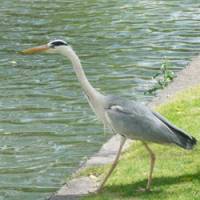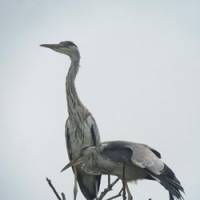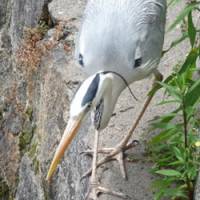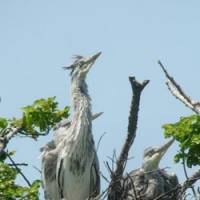A large dark shape flaps in a leisurely fashion on deeply bowed wings across a dark gray sky. It looks somehow lumpy, with very broad, rounded tips to its arched wings — and at a distance it appears like a large black "M," but with long outstretched legs, etched on the glowering clouds.
This is Shakespeare's "harnser," of which Hamlet boasts, "I can tell a hawk from a harnser." Today it is known as the grey heron, or in Japan as aosagi (literally, "blue heron").
In long straight lines, herons etch their traditional routes across the sky, back and forth; between stream and marsh, river and colony. In tall, strong-crowned trees overlooking a river, their forebears have been building their nests for many generations. A loose bundle of sticks piled into an untidy stack spanning a broad fork seems too flimsy a cradle for this large wetland bird, yet the rustic platform will eventually support both parents and their offspring.
Flattering a heron's gawky chicks is, however, no easy matter. They are as ugly as sin, but their parents don't appear to care.
At Matsue Castle in Shimane Prefecture, most visitors are drawn to the dramatic wooden donjon completed in 1622, or to the imposing stone ramparts of the so-called Plover Castle, but on my annual visits there for work or pleasure I always search the moat for basking turtles, then scan the treetops in the castle grounds for herons.
Each time I am drawn to the loose colony of grey herons that call this place home, and invariably position my telescope on the castle's upper floor to check their progress.
Just now, throughout the country from Kyushu to Hokkaido, aosagi are raising their young; early broods will soon be fledging, while later broods continue to writhe their necks skyward demanding ever more food from their exhausted parents.
Leaving the castle for wetlands just a few minutes' heron flight away, I soon spot a tall gray shape, that of a solitary heron standing stoically beside a river. Its long neck, typically hunched into a tight sinuous curve during flight, is now loosely erect. It's watchful, but not yet on the hunt. When hungry, or alert to the presence of a frog or fish, it stiffens, straightening until there is an almost audible tension in that neck, like an overstretched rubber band about to twang. Its whole posture shifts; it begins to lean, slowly, imperceptibly, so that where it was once upright it clearly becomes inclined forward.
In the water beneath the heron's reflection, a dark, unsuspecting shape lazily flicks its tail and inadvertently slips into the danger zone.
The heron is a still image of concentration now. Like a chameleon about to lash out with its tongue at an insect, this hunting bird carefully gauges the distance to its piscine prey. Only once the fish has swum into the death-zone will the harnser strike. When it finally happens, the lunging thrust of that long, daggerlike bill is just like a spear being unleashed from a spear-thrower.
If the heron has judged the distance, the wind, the distorting effect of the water-air interface and the direction and reaction speed of its prey all to perfection, then — in a blur too fast for the human eye to follow — it will seem to be instantaneously holding fresh prey between the tips of its beak.
On many occasions, one or more factors conspire against the heron, not least its prey's own ultra-high-speed response.
Fish and frogs have escape reactions driven by their own genetic imperative for survival. On such occasions, when escape velocity exceeds attack speed, and when the adrenalin rush sends prey away from, not toward, the predator, then the morsel of food escapes the death-zone to live another day as the heron's lunge ends with an empty splash.
Sometimes, even when successful in the first attack, the predator may yet have a battle to subdue its prey. I recall once seeing a heron catch an eel in its beak, only to find a moment later that the slimy thing was writhing around its neck and threatening it with asphyxiation. It took many minutes for the heron to overcome its prey, save its neck and slowly draw in the eel. The last I recall of that eel, before the heron flew off, was seeing it still writhing — but by then deep inside the heron's throat.
In India, meanwhile, I once watched a darter, a more aquatic cousin of our heron, pursue its prey with equally unexpected results. This piscivore has a finer bill than the heron's, and instead of snatching its prey between the points of its beak, it spears it through the body.
As I watched, I saw the darter thrust too boldly at its target, only to find it had the fish far too deeply skewered on its beak for easy removal.
Typically, a deft flick or two is sufficient to send a speared fish into the air so the darter can catch it in its open bill and swallow it — but I counted nearly 30 minutes of flicking and tossing before that fish flew off its skewer. But then the darter, surprised, and perhaps exhausted by its long-awaited success, paused — just too long — and the punctured fish amazingly swam away.
That time spent between first catching prey and then actually consuming it is known to behavioral ecologists as the "handling time," and it is what can often determine the type and size of prey a predator pursues.
After all, there is no point in capturing prey so large that subduing it takes more energy than the calorific reward it yields. Small prey might seem a better choice, as the handling time will be short — but then more time and energy may be consumed overall in capturing sufficient prey than will be derived from their consumption. Judging the appropriate, optimal, meal size — neither too large nor too small — is just one of the many things that a predator must be able to assess.
Meanwhile, as midsummer nears, the noisy "ek-ek-ek" of young herons begging from their treetop nests becomes ever louder.
Venture close below such a heronry, though, and the smell from all the droppings and partly digested food rotting on the ground can be overpowering. Here and there, too, you will likely find carcasses of young birds that fell from their nests dangling and drying pungently in the branches beneath the colony.
For those that have survived to successfully fledge and fly, however, it's not long now before the first of this year's young herons will be out there trying their own chances at the waterside. Though still somewhat ungainly and scrawny in their appearance, and gray, rather than white, about the neck, you may well see them waiting patiently beside stream or river, slowly learning their trade.
Mark Brazil is a naturalist and author who organizes and leads wildlife excursions around Japan by land and sea. His latest book, "Field Guide to the Birds of East Asia" (A & C Black), is available at good bookstores along with his earlier "A Birdwatcher's Guide to Japan." Both titles can also be obtained through [email protected] or via www.wildwatchjapan.com























With your current subscription plan you can comment on stories. However, before writing your first comment, please create a display name in the Profile section of your subscriber account page.